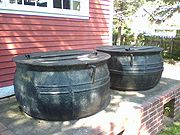
Try pot
Encyclopedia

Blubber
Blubber is a thick layer of vascularized adipose tissue found under the skin of all cetaceans, pinnipeds and sirenians.-Description:Lipid-rich, collagen fiber–laced blubber comprises the hypodermis and covers the whole body, except for parts of the appendages, strongly attached to the musculature...
obtained from cetaceans, pinniped
Pinniped
Pinnipeds or fin-footed mammals are a widely distributed and diverse group of semiaquatic marine mammals comprising the families Odobenidae , Otariidae , and Phocidae .-Overview: Pinnipeds are typically sleek-bodied and barrel-shaped...
s and also to extract oil from penguin
Penguin
Penguins are a group of aquatic, flightless birds living almost exclusively in the southern hemisphere, especially in Antarctica. Highly adapted for life in the water, penguins have countershaded dark and white plumage, and their wings have become flippers...
s. Once a whale had been caught and killed, the process of removing the blubber
Blubber
Blubber is a thick layer of vascularized adipose tissue found under the skin of all cetaceans, pinnipeds and sirenians.-Description:Lipid-rich, collagen fiber–laced blubber comprises the hypodermis and covers the whole body, except for parts of the appendages, strongly attached to the musculature...
from the whale
Whale
Whale is the common name for various marine mammals of the order Cetacea. The term whale sometimes refers to all cetaceans, but more often it excludes dolphins and porpoises, which belong to suborder Odontoceti . This suborder also includes the sperm whale, killer whale, pilot whale, and beluga...
(flensing
Flensing
Flensing is the removing of the outer integument of whales. English whalemen called it "flenching", while American whalemen called it "cutting-in".-Open-boat:-Shore and Bay whaling:...
) began. The raw blubber was then placed in try pots in order to extract the oil.
Early on, oil was rendered from blubber in try pots onshore, not on ships at sea.
On whaler
Whaler
A whaler is a specialized ship, designed for whaling, the catching and/or processing of whales. The former included the whale catcher, a steam or diesel-driven vessel with a harpoon gun mounted at its bows. The latter included such vessels as the sail or steam-driven whaleship of the 16th to early...
s try pots would be built into the deck, a part of the ship known as the trywork
Trywork
A trywork, located aft of the fore-mast, is the most distinguishing feature of a whaling ship.In two cast-iron trypots set into this furnace of brick, iron and wood, whale oil was rendered from the blubber of whales, much as grease is rendered from frying bacon...
s. In the 18th- and 19th-century New England
New England
New England is a region in the northeastern corner of the United States consisting of the six states of Maine, New Hampshire, Vermont, Massachusetts, Rhode Island, and Connecticut...
whaling industry, the use of try-works (two large try pots in a brick furnace) on whaling ships allowed them to stay at sea longer and boil out their oil. The slices of blubber were kept as thin as possible for the process, and on New England whaling ships, these slices were called "bible leaves" by the sailors.
Try-works being used at sea on board a ship was the major technological innovation that enabled the success of the Yankee
Yankee
The term Yankee has several interrelated and often pejorative meanings, usually referring to people originating in the northeastern United States, or still more narrowly New England, where application of the term is largely restricted to descendants of the English settlers of the region.The...
whaling industry.
Further reading
- "Trying Out the Oil", chapter in the book by Peter Cook, You Wouldn't Want to Sail on a 19th-Century Whaling Ship!, New York : Franklin Watts, 2004. ISBN 0-531-16399-7

